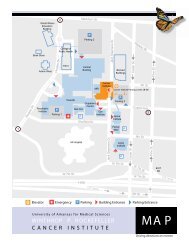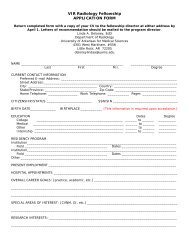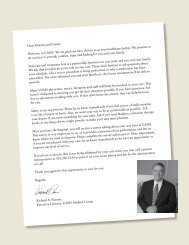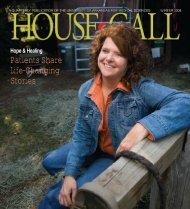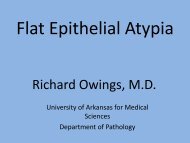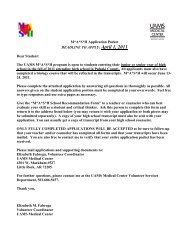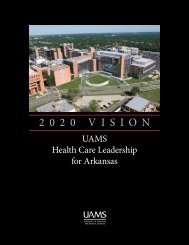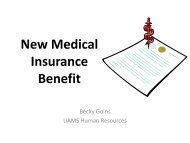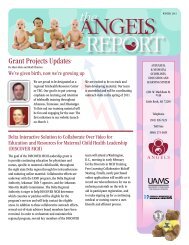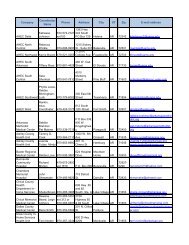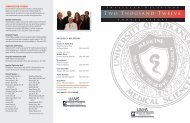telemedicine - UAMS Medical Center
telemedicine - UAMS Medical Center
telemedicine - UAMS Medical Center
You also want an ePaper? Increase the reach of your titles
YUMPU automatically turns print PDFs into web optimized ePapers that Google loves.
A QUARTERLY PUBLICATION OF THE UNIVERSITY OF ARKANSAS FOR MEDICAL SCIENCES spring 2009<br />
<strong>telemedicine</strong><br />
improves stroke<br />
outcomes
House•Call<br />
Spring 2009<br />
editor<br />
Susan Van Dusen<br />
art director<br />
Laurie Shell<br />
managing editor<br />
Liz Caldwell<br />
Welcome<br />
from Chancellor I. Dodd Wilson<br />
On e o f t h e cor nerstones o f <strong>UAMS</strong> is the ability of our<br />
physicians to provide much-needed health care services<br />
throughout the state, often while remaining on our Little<br />
Rock campus. This innovation, known as telehealth, is made<br />
possible through the use of technology and partnerships with health care<br />
professionals across Arkansas.<br />
Led by Dr. Curtis Lowry, our <strong>Center</strong> for Distance Health utilizes<br />
interactive video and audio teleconferencing to allow <strong>UAMS</strong> doctors to<br />
consult in real time with doctors located from Rogers to Lake Village,<br />
and numerous locations in between. Patients who are unable to come<br />
to Little Rock are still able to receive the expert opinion of our highly<br />
trained specialists through the powerful and efficient use of technology.<br />
Telehealth has changed — and will continue to change — the face<br />
of Arkansas health care for years to come. This is evident in one of our<br />
newest programs titled Arkansas SAVES (Stroke Assistance Through<br />
Virtual Emergency Support), a partnership with the state Department of<br />
Health and several Arkansas hospitals.<br />
Arkansas SAVES is intended to improve emergency care for people<br />
experiencing a stroke, when quick response with proper medication can<br />
potentially limit serious complications. Through telehealth technology,<br />
emergency room physicians can consult via video conferencing with a<br />
<strong>UAMS</strong> neurologist, share test results and determine the best treatment<br />
option in the shortest amount of time.<br />
You can read more about Arkansas SAVES on Page 8. Partnerships<br />
such as these are vital to helping <strong>UAMS</strong> improve the health of<br />
Arkansans from all corners of the state.<br />
creative director<br />
Keith Runkle<br />
writers<br />
Nate Hinkel<br />
Jon Parham<br />
David Robinson<br />
Susan Van Dusen<br />
photographer<br />
Johnpaul Jones<br />
editorial advisory board<br />
Kathy Alexander<br />
Jerry Atchley<br />
Anne Bynum<br />
Cindy Pugh<br />
Dale Ronnel<br />
Carla Spainhour<br />
Judy Snowden<br />
Becky Tucker<br />
chancellor<br />
I. Dodd Wilson, M.D.<br />
vice chancellor<br />
of communications & marketing<br />
Pat Torvestad<br />
associate vice chancellor<br />
of communications & marketing<br />
Leslie Taylor<br />
assistant vice chancellor of<br />
communications & marketing<br />
Tim Irby<br />
HouseCall is published quarterly by<br />
<strong>UAMS</strong> Office of Communications &<br />
Marketing, 4301 W. Markham St. #890,<br />
Little Rock, AR 72205-7199<br />
Phone: (501) 686-5686<br />
Fax: (501) 686-6020<br />
Read current and archived issues of<br />
HouseCall online at<br />
www.<strong>UAMS</strong>health.com/housecall<br />
I. Dodd Wilson, M.D.<br />
Chancellor, University of Arkansas for <strong>Medical</strong> Sciences<br />
2 House•Call uamshealth.com
Spring 2009<br />
4<br />
7<br />
8<br />
20<br />
Take it to the Bank<br />
Work is under way to establish Arkansas’ first cord blood bank<br />
<strong>UAMS</strong>health.com<br />
New Web site is designed to be patient friendly<br />
A Matter of Time<br />
Health care providers join forces for stroke patients<br />
The Mind’s Eye<br />
Researchers use a powerful MRI to study the<br />
decision-making process<br />
12<br />
In every issue<br />
12<br />
14<br />
16<br />
18<br />
Builders<br />
Momentum grows on the Northwest Arkansas campus<br />
Healers<br />
Dr. Youmin Wu leads the liver transplant program<br />
Did You Know<br />
Newsworthy happenings at <strong>UAMS</strong><br />
Scholars<br />
Faculty member creates a model for respiratory care education<br />
18<br />
22<br />
Partners<br />
Sheila Mehaffy watched the Psychiatric Research Institute<br />
go from dream to reality<br />
On the cover: Dr. Salah Keyrouz leads a new telehealth<br />
program designed to improve stroke outcomes.<br />
Cover photo: Johnpaul Jones<br />
22<br />
uamshealth.com House•Call 3
Dr. Michele Fox is a leader in the effort<br />
to start Arkansas' first cord blood bank,<br />
which will house specialized equipment<br />
on the <strong>UAMS</strong> campus.<br />
4 House•Call uamshealth.com
to the<br />
take it<br />
bank<br />
Cord blood bank at <strong>UAMS</strong> will save<br />
lives and enhance research<br />
By Nate Hinkel<br />
Dr. Michele Fox knows the potential<br />
benefits in research and health care if her<br />
groundbreaking efforts in establishing a<br />
statewide cord blood bank are realized.<br />
“They are undeniable and far reaching<br />
with enormous healing and life-saving<br />
capability,” said Fox, a <strong>UAMS</strong> professor of<br />
pathology and director of Cell Therapy and<br />
Transfusion Medicine.<br />
Though the potential is crystal clear, Fox’s<br />
mission has been spreading the word, drumming<br />
up support and breaking down misconceptions<br />
that might have initially clouded the picture.<br />
And it’s working. Fox has secured the<br />
backing of state government, the medical<br />
community and a growing number of donors<br />
who realize the importance of keeping Arkansas<br />
on the cutting edge of this trailblazing effort. »<br />
uamshealth.com House•Call 5
take it<br />
bank<br />
to the<br />
Striking a Cord In March<br />
2007, state legislators<br />
unanimously approved<br />
legislation to allow Arkansas<br />
to begin storing and<br />
researching blood cells<br />
harvested from umbilical<br />
cords following the<br />
birth of healthy<br />
children.<br />
Those cells<br />
are used in transplants<br />
for cancer patients who do not<br />
have a bone marrow donor, but they also have<br />
tremendous promise for regenerating diseased or<br />
injured organs, including dead heart muscle, bone and<br />
spinal cord tissue. The umbilical<br />
cord, placenta and amniotic fluid,<br />
all of which are typically discarded<br />
after birth, are rich in stem cells<br />
that can be withdrawn without<br />
destroying embryos.<br />
Included in the legislation was<br />
an initiative to set up a statewide<br />
cord blood banking network — an integral part of<br />
the effort with the goal of aiding in the collection and<br />
transportation of donated cord blood.<br />
“The public has shown great interest in donating<br />
cord blood for research or to be banked, but the only<br />
way to do that has been to pay for costly storage<br />
through a private bank,” Fox said.<br />
Bank it Here Equipment to establish and run the<br />
bank is being been purchased with the support of<br />
donors and leadership at <strong>UAMS</strong>.<br />
Since <strong>UAMS</strong> is home to one of the largest adult<br />
blood cell transplant centers in the country, Fox’s<br />
division will host the central bank and be the main<br />
storage site under the <strong>UAMS</strong> umbrella. Once in<br />
operation, the cord blood bank will be linked with<br />
national and international networks of cord blood<br />
banks that supply these cells for transplant all<br />
over the world.<br />
Fox’s mission has been<br />
spreading the word,<br />
drumming up support<br />
and breaking down<br />
misconceptions.<br />
“For example, the nearest cord blood bank is in<br />
St. Louis, and it’s credited with saving more than 550<br />
lives annually,” Fox said.<br />
Check-Off On It An anonymous donor has<br />
guaranteed $250,000 in matching funds to help<br />
establish the cord blood bank and network, a goal Fox<br />
said is well on its way to being met through several<br />
fundraising efforts.<br />
No funding was included in the original legislation,<br />
but an income tax check-off program was part of<br />
the package. The program allows contributions from<br />
taxpayers to the Newborn Umbilical Cord Blood<br />
Initiative to be automatically deducted from their<br />
refund checks for whatever amount they wish to give.<br />
“Our hope is that by having this option available<br />
to Arkansans, an initial funding<br />
stream is created that will open<br />
up the flood gates for this valuable<br />
program,” said Tim Clark, an<br />
Arkansas businessman whom Gov.<br />
Beebe appointed chairman of the<br />
Arkansas Commission for the<br />
Newborn Umbilical Cord Blood<br />
Initiative. The 11-member commission, to which<br />
Fox serves as a consultant, was created in the initial<br />
legislation to lead the effort to establish the cord blood<br />
bank and network.<br />
Fox said the program was successful in its first year<br />
with more than 1,100 tax refund donations, but she<br />
expects higher numbers this tax season.<br />
The tax program, along with a public relations<br />
effort featuring spokespeople Ginger Beebe, Arkansas’<br />
first lady, and Clark, looks to secure more funding and<br />
the licensing the bank and network needs to<br />
be operational later this year.<br />
check it out!<br />
With further research and an efficient cord<br />
blood banking system, more than 100 million<br />
Americans and 2 billion people worldwide<br />
could potentially be treated or cured. For<br />
more information or to make a donation,<br />
contact Brooke Ivy at (501) 686-7203 or<br />
bivy@uams.edu.<br />
6 House•Call uamshealth.com
W<br />
hether<br />
you are<br />
seeking<br />
general<br />
health information or<br />
treatment for a specific<br />
condition, <strong>UAMS</strong>’ new<br />
Web site is just a click away.<br />
“<strong>UAMS</strong>health.com was designed<br />
from a patient’s perspective,” said Lannie Byrd,<br />
<strong>UAMS</strong> Web <strong>Center</strong> director. “We tried to<br />
“We tried to<br />
capture every<br />
aspect a patient<br />
would need.”<br />
capture every aspect a patient would<br />
need when searching for health care<br />
information or services.”<br />
The site will include many features<br />
designed to increase convenience,<br />
including online prescription refills<br />
and online bill pay. Printable maps provide detailed<br />
information on navigating the <strong>UAMS</strong> campus, and an<br />
New <strong>UAMS</strong>health.com is filled with<br />
patient-friendly features By Susan Van Dusen<br />
online giving form makes it easy to donate to<br />
<strong>UAMS</strong>’ institutes and colleges with a Visa,<br />
Mastercard, American Express or Discover card.<br />
Visitors can easily<br />
locate information about<br />
physicians specially<br />
trained to treat specific<br />
conditions and<br />
can access contact<br />
information for <strong>UAMS</strong>’<br />
many outpatient clinics.<br />
“The interactive<br />
tools are some of the most<br />
outstanding features of the<br />
new site. Visitors can access the<br />
information they need in any number<br />
of ways,” Byrd said.<br />
An extensive medical library includes<br />
articles on conditions from allergies to cancer,<br />
along with audio podcasts, videos, interactive<br />
quizzes and risk assessment tools.<br />
Calculators are available to help users<br />
determine such things as their body mass index, their<br />
baby’s due date, their child’s estimated adult<br />
height and more.<br />
When a search topic is entered, the site<br />
automatically displays links to <strong>UAMS</strong><br />
news, medical services, health articles and<br />
multimedia, giving visitors several options<br />
from which to choose.<br />
“We are so pleased to have launched<br />
this new site in conjunction with the<br />
opening of the new <strong>UAMS</strong> hospital,” Byrd said. “It will<br />
be a valuable tool for our patients and visitors.”<br />
uamshealth.com House•Call 7
A Matter<br />
of Time<br />
<strong>UAMS</strong> and rural hospitals join forces<br />
to provide a life-saving stroke drug<br />
By David Robinson<br />
J<br />
oseph Fritz was going about his morning<br />
household chores in Clarksville when he noticed<br />
his mother, Hilda, slumped in her chair.<br />
His first thought, which turned out to be<br />
correct, was stroke. “One side of her body was<br />
totally unresponsive,” Joseph recalled of that<br />
Nov. 12, 2008, day.<br />
The emergency response that followed was historic<br />
for Arkansas and a first for <strong>UAMS</strong>’ <strong>Center</strong><br />
for Distance Health. Less than two weeks earlier,<br />
Johnson Regional <strong>Medical</strong> <strong>Center</strong> in Clarksville had<br />
joined a new program led by <strong>UAMS</strong> that improves<br />
rural residents’ likelihood of surviving and recovering<br />
from stroke.<br />
Like all patients with stroke symptoms, it was<br />
critical that Hilda be treated within three hours for<br />
the best chance of survival and a good outcome. As<br />
part of the new Arkansas SAVES (Stroke Assistance<br />
Through Virtual Emergency Support) program, the<br />
local ambulance’s EMTs had received special stroke<br />
training. The EMTs relayed their stroke assessment to<br />
the emergency room while en route, and the doctor<br />
was ready for Hilda when she arrived. A battery of tests<br />
followed, including a CT scan of the brain.<br />
Each step helped lead to the correct stroke<br />
diagnosis, but the most important step involved a<br />
board-certified vascular neurologist based at <strong>UAMS</strong>.<br />
Proper Assessment About 80 percent of strokes are<br />
ischemic, meaning clogged blood vessels are starving<br />
the brain of oxygen. Under a neurologist’s guidance,<br />
patients can receive<br />
“Without the drug<br />
therapy, my mom<br />
wouldn’t have<br />
had a chance<br />
to recover.”<br />
the clot-busting<br />
drug called t-PA.<br />
Patients who<br />
receive the drug<br />
for ischemic stroke<br />
within three hours<br />
have the best<br />
chance of recovery.<br />
Hemorrhagic stroke occurs when a blood vessel<br />
ruptures and bleeds into surrounding brain tissue. t-PA<br />
cannot be used for a hemorrhagic stroke, as it is likely<br />
to worsen the condition and could even be fatal. »<br />
8 House•Call uamshealth.com
Dr. Salah Keyrouz is medical<br />
director of Arkansas SAVES.<br />
uamshealth.com House•Call 9
After consultation with a neurologist, doctors in rural hospitals have the assurance of administering the potentially<br />
life-saving t-PA drug.<br />
“Differentiating between these two types of<br />
stroke is important; only ischemic strokes could<br />
benefit from t-PA” said Dr. Salah Keyrouz, a <strong>UAMS</strong><br />
neurologist and the Arkansas SAVES medical<br />
director.<br />
Many smaller hospitals like the one in Clarksville<br />
have t-PA, but the drug has stayed on the shelf.<br />
The risk of using it is simply too great without<br />
consultation with a neurologist.<br />
This situation inspired <strong>UAMS</strong> — through its<br />
<strong>Center</strong> for Distance Health — and the forward<br />
thinking of the Department of Human Services<br />
Division of <strong>Medical</strong> Services to create the SAVES<br />
program, which eventually will connect rural<br />
hospitals across the state with life-saving expertise of<br />
neurologists on call 24 hours a day.<br />
The McGehee-Desha County Hospital in<br />
Southeast Arkansas joined the SAVES program in<br />
February, to the excitement and relief of John Heard,<br />
that hospital’s chief executive officer.<br />
“I can’t think of one time in the six years I’ve been<br />
here that we’ve used t-PA,” Heard said. “Could it have<br />
been given? Of course. But we didn’t have the SAVES<br />
program, which is imperative.”<br />
10 House•Call uamshealth.com
Called Into Action When Hilda’s CT scan and<br />
other tests indicated an ischemic stroke, the attending<br />
physician called a special hotline to activate the<br />
Arkansas SAVES Telestroke System. The call went to<br />
a nurse at the <strong>UAMS</strong> <strong>Center</strong> for Distance Health Call<br />
<strong>Center</strong> who then linked — via a video connection<br />
— an on-call neurologist with the Johnson Regional<br />
<strong>Medical</strong> <strong>Center</strong>’s ER physician.<br />
In Hilda’s case, Keyrouz received the call at<br />
<strong>UAMS</strong>. He had immediate access to the local<br />
hospital’s lab results, a high-resolution CT brain<br />
image and a real-time, high-definition video/audio<br />
connection with the<br />
“This is going to<br />
save a lot of<br />
people's lives.”<br />
ER physician, Dr. James<br />
Goodman, and Hilda.<br />
Keyrouz confirmed the<br />
diagnosis and t-PA was<br />
used.<br />
Hilda, 92, had lost her speech and ability to<br />
swallow, as well as other muscle functions. She’s now<br />
regained her ability to speak and swallow, but she’s<br />
still recovering in a local rehabilitation clinic, and<br />
Joseph is grateful she has the opportunity.<br />
“Without the drug therapy, my mom wouldn’t<br />
have had a chance to recover,” Joseph said. “I thought<br />
that I had lost her.”<br />
The Arkansas SAVES system relies on the state<br />
Health Department’s hospital preparedness highspeed<br />
video network transmission lines that provide<br />
the live video communication. The <strong>telemedicine</strong><br />
equipment links neurologists — two at <strong>UAMS</strong><br />
and one at Sparks Regional Health System in Fort<br />
Smith — with rural hospital emergency rooms. The<br />
neurologists, who are on call 24 hours a day, also have<br />
<strong>telemedicine</strong> equipment at their homes.<br />
“This is cool stuff,” Heard said. “This is going to<br />
save a lot of people’s lives.”<br />
Still, Heard and other experts stress that<br />
Arkansas will need to do even more to improve its<br />
stroke ranking.<br />
“Prevention should be our ultimate quest,”<br />
Keyrouz said. “But short of that, Arkansas SAVES is<br />
the best program we have for treating strokes<br />
in Arkansas.”<br />
He noted that high blood pressure, diabetes,<br />
smoking, age, high cholesterol and lack of exercise are<br />
all risk factors for stroke. It’s important that the public<br />
be aware of the signs and symptoms of a stroke, such<br />
as sudden weakness, numbness, unsteady gait and<br />
speech problems.<br />
<br />
Arkansas SAVES Facts<br />
The Arkansas SAVES Program began Nov. 1,<br />
2008, with a contract with Arkansas Department of<br />
Human Services, Division of <strong>Medical</strong> Services and the<br />
<strong>UAMS</strong> <strong>Center</strong> for Distance Health.<br />
Partner hospitals so far include: Booneville<br />
Community Hospital, Johnson Regional <strong>Medical</strong><br />
<strong>Center</strong>, Mena Regional Health System, McGehee-<br />
Desha County Hospital and DeWitt Hospital.<br />
Hospitals expected to join the program by July<br />
include: Helena Regional <strong>Medical</strong> <strong>Center</strong> in Helena-<br />
West Helena, Baxter Regional <strong>Medical</strong> <strong>Center</strong> in<br />
Mountain Home, White River <strong>Medical</strong> <strong>Center</strong> in<br />
Batesville and Baptist Health-Arkadelphia.<br />
Three neurologists are on call 24 hours a day to<br />
provide their life-saving expertise via a <strong>telemedicine</strong><br />
link with community hospital emergency rooms. They<br />
are: Dr. Salah Keyrouz, the Arkansas SAVES medical<br />
director; Dr. James Schmidley, professor of neurology<br />
at <strong>UAMS</strong>; and Dr. Margaret Tremwel, a neurologist at<br />
Sparks Regional Health System in Fort Smith.<br />
uamshealth.com House•Call 11
<strong>UAMS</strong> builders<br />
T<br />
he <strong>UAMS</strong> satellite campus in Fayetteville<br />
is finding widespread support and its first<br />
students are expected to arrive this fall.<br />
In 2008, more than $3 million was<br />
pledged toward the <strong>UAMS</strong> expansion. Those funds are<br />
helping pay for renovations to the former Washington<br />
Regional <strong>Medical</strong> <strong>Center</strong> building to accommodate<br />
the campus. The <strong>UAMS</strong> Area Health Education<br />
<strong>Center</strong> (AHEC) Northwest also will move its existing<br />
health education and medical care programs into the<br />
facility this year. Fundraising is continuing with a $17<br />
million goal to fully renovate and prepare the facility.<br />
“We’re finding our donors understand how<br />
important this effort is to the region and the entire<br />
state,” said Dr. Peter O. Kohler, vice chancellor for<br />
the northwest Arkansas region. “It will allow us to<br />
increase our enrollment in a way not possible on our<br />
Little Rock campus and produce more physicians,<br />
nurses, pharmacists and allied health professionals in<br />
the future.”<br />
Giving was highlighted in November 2008 when<br />
a trio of Arkansas philanthropists gave a total of $1.5<br />
million toward the effort. Donations of $500,000 each<br />
were announced from Don Tyson and the Tyson<br />
Family Foundation, the Willard and Pat Walker<br />
Charitable Foundation and Johnelle Hunt. That gift<br />
was announced two days after a $300,000 gift to the<br />
project from the Walton Family Foundation.<br />
There also was a $100,000 gift in August<br />
2008 from the Northwest Arkansas Community<br />
Foundation, a group whose mission is encouraging<br />
philanthropy across the region.<br />
“It is exciting to see the momentum building<br />
behind the <strong>UAMS</strong> satellite campus because of<br />
the long-lasting impact it will have on the state,”<br />
said Johnelle Hunt, widow of J.B. Hunt Transport<br />
Services Inc. founder J.B. Hunt<br />
and a longtime member of that<br />
company’s board of directors, on<br />
the day the gift was announced.<br />
Opening Soon Renovations<br />
will be under way this spring,<br />
Kohler said. By September, the<br />
AHEC is expected to move into<br />
its new home. A month later, about five or six medical<br />
students will arrive in what Kohler termed a trial run<br />
for the campus.<br />
Ultimately, the campus will have 250 to 300<br />
students along with resident physicians when full<br />
enrollment is reached. He said that will not happen<br />
until 2012, when the renovation work is complete<br />
with laboratory equipment and other resources to<br />
accommodate the pharmacy, allied health and other<br />
students who will fill out enrollment.<br />
Kohler said medical and pharmacy students will<br />
complete their first two years of school at the <strong>UAMS</strong><br />
campus in Little Rock. Then some could transfer to<br />
the satellite campus to complete the last two years.<br />
Northwest Arkansas was identified as the prime<br />
location for the campus because it has enough<br />
potential clinical partners — including hospitals,<br />
clinics and pharmacies — where students and<br />
resident physicians gain experience with the latest<br />
medical technology or treating real patients in<br />
supervised settings. The <strong>UAMS</strong> campus in Little<br />
Rock and <strong>UAMS</strong> programs<br />
around the state<br />
that host clinical<br />
education for<br />
students and<br />
resident physicians<br />
are not able to<br />
accommodate<br />
enough new<br />
students, Kohler<br />
said.<br />
check it out!<br />
Find out more at<br />
www.uams.edu/nw.<br />
For the satellite campus,<br />
<strong>UAMS</strong> plans residency<br />
programs in internal<br />
medicine, obstetrics/<br />
gynecology, pediatrics,<br />
psychiatry and surgery, in<br />
addition to a family medicine<br />
program that already exists<br />
in the AHEC.<br />
12 House•Call uamshealth.com
“Our donors<br />
understand how<br />
important this<br />
effort is to the<br />
region and the<br />
entire state.”<br />
Dr. Peter Kohler is leading <strong>UAMS</strong>'<br />
effort in northwest Arkansas.<br />
uamshealth.com House•Call 13
<strong>UAMS</strong> Healers<br />
Transplant surgeon's<br />
expertise is a lifesaver<br />
for liver cancer patient<br />
By David Robinson<br />
D<br />
14 House•Call uamshealth.com
C<br />
all it luck or divine intervention, but<br />
Danny Stobaugh found <strong>UAMS</strong>’<br />
Dr. Youmin Wu in the nick of time.<br />
The day after Thanksgiving 2007,<br />
Stobaugh was so jaundiced that he was taken to a<br />
Little Rock hospital. His blood tests told doctors he<br />
had cancer, but exploratory surgery failed to find it.<br />
As he approached his third week in the hospital, he<br />
was visited by Dr. Kent Westbrook, a longtime friend<br />
who also is a cancer surgeon at <strong>UAMS</strong>.<br />
Westbrook suggested that Stobaugh go to <strong>UAMS</strong><br />
and see Wu, who established <strong>UAMS</strong>’ liver transplant<br />
program in 2005. In early January 2008, Wu<br />
diagnosed Stobaugh with a rare cancer of the liver,<br />
hilar cholangiocarcinoma.<br />
“The other doctors couldn’t find the cancer, but<br />
with the blessing of the good Lord, Dr. Wu did,” said<br />
Stobaugh, 59, who spent his investment banking<br />
career in Little Rock and Russellville and is now<br />
retired with his wife, Paula, in Gulf Shores, Ala. “The<br />
cancer was in the bile duct; it was a very rare cancer.”<br />
Even more fortunate for Stobaugh, Wu happened<br />
to be one of the few surgeons in the world with<br />
a track record for helping patients beat hilar<br />
cholangiocarcinoma.<br />
Wu’s documented success, published in Liver<br />
Transplantation, helped convince the United<br />
Network for Organ Sharing (UNOS) to put Stobaugh<br />
on a waiting list for a donor liver. UNOS had initially<br />
rejected the request because so few patients survive<br />
the cancer, even with a new liver.<br />
Wu’s approach required marshaling a force<br />
of <strong>UAMS</strong> specialists, including a hepatologist,<br />
“The other doctors couldn’t<br />
find the cancer, but with the<br />
blessing of the good Lord,<br />
Dr. Wu did.”<br />
pathologist, radiologist, radiation oncologist and<br />
hematologist/oncologist.<br />
“This is the real strength of <strong>UAMS</strong>,” Wu said.<br />
“There’s no place else in this region that can provide<br />
a patient like Mr. Stobaugh such a sophisticated<br />
multidisciplinary effort.”<br />
After undergoing radiation and chemotherapy,<br />
Stobaugh received a transplant on March 25, 2008.<br />
“I’m here today thanks to the Lord and Dr. Wu,”<br />
said Stobaugh, who expected to die from the cancer<br />
before seeing Wu. “I don’t think people realize what a<br />
treasure <strong>UAMS</strong> is; I sure didn’t.”<br />
Building on Success<br />
Since arriving at <strong>UAMS</strong> in 2005, Dr. Youmin<br />
Wu has built a liver transplant program with near<br />
perfect one-year survival rates. His team includes<br />
Dr. Frederick Bentley, a liver transplant surgeon, and<br />
Dr. Gary Barone, a kidney and pancreas transplant<br />
surgeon who also assists with liver transplants.<br />
In January, the Scientific Registry for Transplant<br />
Recipients reported that <strong>UAMS</strong>’ one-year patient<br />
survival rate was 98.25 percent, compared with<br />
the national average of 87.85 percent. <strong>UAMS</strong> has<br />
performed almost 100 liver transplants since its<br />
program was established three years ago.<br />
“We have an experienced team that works well<br />
together,” Wu said. “Their expertise ensures the best<br />
possible outcome for our patients.”<br />
uamshealth.com House•Call 15
Did<br />
Know?<br />
You<br />
Wilson Education Building<br />
When visitors enter the <strong>UAMS</strong> campus, one of the first sites<br />
they see is a new building bearing the name of <strong>UAMS</strong> Chancellor<br />
I. Dodd Wilson. The naming was announced at a ceremony<br />
in late 2008.<br />
The two-floor I. Dodd Wilson Education Building includes<br />
16 classrooms and two auditoriums to accommodate growing<br />
enrollment in the five colleges and graduate school at <strong>UAMS</strong>. The<br />
naming recognizes more than two decades of growth at <strong>UAMS</strong><br />
during Wilson’s tenure, first as College of Medicine dean and since<br />
2000 as chancellor.<br />
J. Thomas May<br />
ALS Research <strong>Center</strong><br />
A Pine Bluff banker was recently<br />
honored by the naming of laboratories<br />
dedicated to finding new treatments for<br />
a crippling neurodegenerative disease.<br />
The J. Thomas May <strong>Center</strong><br />
for Amyotrophic Lateral Sclerosis<br />
(ALS) Research has a focus on<br />
translational medicine, meaning that it<br />
seeks to move new treatments quickly<br />
from the laboratory to the clinic.<br />
The center is supported by more<br />
than $1 million in gifts to <strong>UAMS</strong> in<br />
honor of May, who is chairman and<br />
chief executive officer of Simmons<br />
First National Corp. and Simmons First<br />
National Bank. He has been diagnosed<br />
with ALS, a condition that typically<br />
strikes otherwise healthy people<br />
and robs them of all voluntary<br />
muscle function.<br />
16 House•Call uamshealth.com
Art on Display<br />
Fans of renowned glass artist James Hayes can<br />
view the largest permanent collection of his art at the<br />
<strong>UAMS</strong> Psychiatric Research Institute.<br />
Hayes, an Arkansas native, created the series to<br />
be displayed throughout the psychiatric facility. The 44<br />
wall hangings were designed to honor donors who have<br />
made significant contributions to the Institute.<br />
Dr. G. Richard Smith is chairman of the <strong>UAMS</strong><br />
Department of Psychiatry and director of the Psychiatric<br />
Research Institute.<br />
New<br />
Approach to<br />
Heart Surgery<br />
Patricia Ernst of Jacksonville became a<br />
<strong>UAMS</strong> first when she recently underwent<br />
two procedures at once to alleviate<br />
blockages in three of her coronary arteries.<br />
Ernst normally would have received<br />
three heart bypasses but instead received<br />
a rare hybrid: two stents inserted by<br />
<strong>UAMS</strong> cardiologist Dr. Behzad Molavi,<br />
and one bypass by<br />
Dr. Gareth Tobler, a<br />
cardiothoracic surgeon.<br />
A stent is a wire mesh<br />
tube that holds arteries<br />
open to improve blood flow.<br />
Rarely do patients have a<br />
cardiologist and cardiothoracic<br />
surgeon working in concert<br />
to offer both<br />
procedures,<br />
and this is<br />
believed to be<br />
the first time it<br />
was performed in<br />
Arkansas.<br />
Dr. Jeanne Wei<br />
Institute on Aging Director Named<br />
Dr. Jeanne Wei has been named executive director of<br />
the <strong>UAMS</strong> Donald W. Reynolds Institute on Aging<br />
and chairman of the Donald W. Reynolds Department of<br />
Geriatrics in the College of Medicine, where, since 2002,<br />
she has served as professor and executive<br />
vice chairman.<br />
As a geriatrician, cardiologist, scientist, teacher<br />
and academic administrator, Wei has more than 20<br />
years of experience in developing academic programs<br />
and clinical initiatives. She is board certified by the<br />
American Board of Internal Medicine in internal medicine<br />
and in the subspecialties of cardiovascular medicine and<br />
geriatric medicine.<br />
uamshealth.com House•Call 17
<strong>UAMS</strong> scholars<br />
Kathy Rye was honored for<br />
her contributions to respiratory<br />
care education.<br />
18 House•Call uamshealth.com
Breathing Easier<br />
<strong>UAMS</strong> faculty member creates a<br />
national model for respiratory care education By Jon Parham<br />
Kathy Rye was in her late teens when her<br />
grandfather developed progressive lung<br />
disease.<br />
Living nearby, she had to watch as<br />
chronic obstructive pulmonary disease affected the<br />
breathing and quality of life for the man who once<br />
taught her to ride a horse. Rye said it ultimately guided<br />
her career into respiratory therapy.<br />
“I saw the difference the various respiratory<br />
therapists he saw were making in helping him cope<br />
with the effects of the disease,” Rye said.<br />
She was in college by the time he died and soon<br />
changed her major from elementary education to<br />
respiratory care.<br />
Today Rye is director of clinical education and<br />
an associate professor in the <strong>UAMS</strong> respiratory care<br />
program. She was recently selected by her peers for<br />
the Specialty Practitioner of the Year Award from the<br />
Education Section<br />
“The clinical<br />
preceptor becomes<br />
part role model,<br />
part mentor.”<br />
of the American<br />
Association for<br />
Respiratory Care.<br />
Rye was<br />
recognized in part<br />
for developing a<br />
clinical preceptor program that helps respiratory<br />
therapists who host students in hospitals or clinics to<br />
be effective teachers, while also giving the students<br />
clinical experience.<br />
“She was very intuitive about what was needed<br />
in the clinical setting to make a successful experience<br />
for students,” said Erna Boone, chairman of the<br />
<strong>UAMS</strong> Department of Respiratory Care and Surgical<br />
Technologies. “Kathy’s award was a huge endorsement<br />
for the quality of program we have.”<br />
The proof also is in the numbers. More than 90<br />
percent of <strong>UAMS</strong> respiratory care students passed<br />
the clinical portion of their national registry exam in<br />
2007-2008, compared to the 56 percent national rate.<br />
Rye said the clinical phase of the respiratory care<br />
program is the cornerstone of a student’s education<br />
experience. Thus it is critical that the preceptors are<br />
effective teachers.<br />
Students gain their basic knowledge in the<br />
classroom. They also learn treatment and therapy<br />
techniques using manikins, Rye said. But nothing<br />
compares to observing and working with real patients<br />
in a supervised setting.<br />
During this experience, the clinical preceptor<br />
becomes part role model, part mentor. “I still<br />
remember my mentor’s enthusiasm for the<br />
profession,” Rye said. “It is the characteristics of<br />
preceptors and the clinical environment that they<br />
create that makes the learning experience rewarding<br />
and productive for all participants.”<br />
Love of the profession and the “patient first” focus<br />
are important traits in preceptors, she said.<br />
Rye, who joined the <strong>UAMS</strong> faculty in 1993,<br />
started developing the preceptor program while she<br />
was a graduate student. Since its adoption, more<br />
than 200 therapists have been trained to serve as<br />
preceptors in Arkansas.<br />
“Most of the preceptors I talk to find the<br />
experience rewarding. They feel like through working<br />
with the students, they are giving back to their<br />
profession,” she said.<br />
She now gets regular<br />
calls and e-mails from<br />
respiratory care programs<br />
across the country,<br />
seeking advice on setting<br />
up or developing their<br />
own preceptor education<br />
programs.<br />
check it out!<br />
There are about<br />
400 respiratory<br />
care educational<br />
programs in the<br />
United States.<br />
Find out more at<br />
www.uams.edu/<br />
chrp/respiratorycare.<br />
uamshealth.com House•Call 19
A new MRI scanner<br />
will give researchers a<br />
glimpse into the brain’s<br />
decision-making process<br />
By Nate Hinkel<br />
Imagine asking someone a question and then<br />
receiving a detailed image of where the person’s<br />
answer was processed in the brain.<br />
It might sound like science fiction, but it’s<br />
already happening at the <strong>UAMS</strong> Psychiatric Research<br />
Institute, thanks to the addition of a powerful new<br />
MRI scanner.<br />
“This instrument will significantly advance<br />
our research into addiction and other challenging<br />
behaviors,” said Dr. Warren Bickel, director of<br />
the Psychiatric Research Institute’s <strong>Center</strong> for<br />
Addiction Research.<br />
In the final weeks before the new $32 million,<br />
110,000-SF Institute opened late last fall, a specialized<br />
20 House•Call uamshealth.com
Jeff Pitcock stands next to<br />
the 3 Tesla MRI Scanner.<br />
The scanner<br />
is able to<br />
produce a<br />
magnetic field<br />
60,000 times<br />
stronger than<br />
the Earth's.<br />
forklift meticulously lifted the 10,000-pound 3 Tesla<br />
MRI scanner into a custom-designed hole in the<br />
wall at the Helen L. Porter and James T. Dyke Brain<br />
Imaging Research <strong>Center</strong>. The scanner, which cost<br />
about $3 million, contains a superconducting magnet<br />
that is able to produce a magnetic field 60,000 times<br />
stronger than the Earth’s.<br />
Ask and Receive The human brain is small compared<br />
to the rest of the body’s internal organs, weighing only<br />
roughly three pounds. But the control it maintains over<br />
the rest of the body, including all forms of movement<br />
and behavior, is immense.<br />
That’s why it is so important to understand the<br />
inner workings of the brain and to be able to study<br />
it thoroughly.<br />
The 3 Tesla system will be used for research by the<br />
Psychiatric Research Institute as well as for clinical<br />
diagnoses by the Department of Radiology. Research<br />
will include the assessment of brain function associated<br />
with the decision-making process of subjects in the<br />
MRI scanner.<br />
“We’ll present them with questions while they are<br />
in the scanner and be able to observe increasing blood<br />
flow associated with neural effort,” said Jeff Pitcock, a<br />
neuroimaging data analyst with the Institute’s <strong>Center</strong> for<br />
Addiction Research. “We’ll see how these people make<br />
decisions and be able to collect images of where the<br />
blood flow is increasing or decreasing.”<br />
Mind Over Matter Pitcock, whose job it is to design<br />
functional imaging projects and analyze their data, says<br />
the scanner will provide new and important information<br />
regarding the future of mental illness treatment.<br />
“What it does is offer researchers a very safe and<br />
non-invasive technique to identify areas of the brain<br />
that may be responsible or correlated with illness or<br />
disruptive behaviors,” Pitcock said. “That’s the first step<br />
into being able to translate the research into a clinical<br />
intervention of some sort.”<br />
Being able to determine the exact cause and<br />
location of a problem within the brain often requires<br />
major surgery. The MRI will allow clinicians and<br />
researchers to witness the human thought process in<br />
action, without making a single incision.<br />
“More specifically,<br />
it will permit us to<br />
see how the brain of<br />
the addicted person<br />
operates differently<br />
from the rest of us,”<br />
Bickel said.<br />
check it out!<br />
The 3 Tesla MRI<br />
system is one of only<br />
two in Arkansas, as<br />
a similar unit is being<br />
used by the <strong>UAMS</strong><br />
Department<br />
of Radiology.<br />
uamshealth.com House•Call 21
<strong>UAMS</strong> partners<br />
W<br />
hen bipolar disorder struck her<br />
daughter about 15 years ago, Sheila<br />
Mehaffy was both disappointed and<br />
inspired by what followed.<br />
She learned, like so many others in Arkansas, that<br />
mental illness treatment options were severely limited.<br />
And the stigma associated with the disease only<br />
aggravated the situation — even her daughter’s private<br />
insurance did not cover her condition.<br />
January 2005, also credits the tireless work of<br />
Dr. G. Richard Smith, chairman of the <strong>UAMS</strong><br />
Department of Psychiatry and the Institute’s director.<br />
“Dr. Smith traveled all over Arkansas to visit with<br />
potential supporters and the public at large to help<br />
them understand the need for a Psychiatric Research<br />
Institute,” Mehaffy said. “Dr. Smith and members of<br />
his staff and the volunteers all worked very hard,<br />
and as a result we began to see contributions<br />
Un c o m m o n<br />
Fo c u s<br />
Sheila Mehaffy was part of a determined group of<br />
supporters for the Psychiatric Research Institute<br />
By David Robinson<br />
Eventually her daughter found treatment at<br />
<strong>UAMS</strong>, and today she is a healthy, active wife and<br />
mother of three.<br />
Mehaffy, meanwhile, became part of a group of<br />
private supporters dedicated to helping <strong>UAMS</strong> build a<br />
new Psychiatric Research Institute. Many in the group<br />
were bound by similar experiences with mental illness<br />
in their families and friends.<br />
“Mental illness treatment and helping our state<br />
overcome the stigma became a real passion of mine,”<br />
she said.<br />
Despite their commitment to raising funds for<br />
the new Iinstitute, success came slowly. The group<br />
encountered misunderstandings about mental illness<br />
that stymied its efforts. Still, the <strong>UAMS</strong> supporters<br />
and leaders from the <strong>UAMS</strong> Department of Psychiatry<br />
persevered and incorporated an education component<br />
in November 2003 called the Beautiful Minds<br />
Program.<br />
Mehaffy was one of the founders of the monthly<br />
program, which continues today with luncheonlectures<br />
on mental illness topics at the Country Club<br />
of Little Rock and Pleasant Valley Country Club.<br />
Mehaffy, who became a member of the <strong>UAMS</strong><br />
Psychiatric Research Institute Advisory Board in<br />
grow. It was tremendously exciting to watch.”<br />
About $10 million in private funds were raised,<br />
and on Dec. 2, 2008, Mehaffy and hundreds of other<br />
supporters celebrated the grand opening of the new<br />
Psychiatric Research Institute building. The 40-bed,<br />
$32 million facility, whose six stories encompass<br />
“Mental illness<br />
treatment and<br />
helping our state<br />
overcome the stigma<br />
became a real<br />
passion of mine.”<br />
110,000 square<br />
feet, is one of only<br />
nine institutions<br />
in the country<br />
combining research<br />
and education<br />
with inpatient and<br />
outpatient care.<br />
Mehaffy, a<br />
graduate of Randolph Macon Woman’s College in<br />
Lynchburg, Va., loves gardening in her free time, and<br />
she’s active in her church, Trinity Episcopal Cathedral<br />
in Little Rock. But she also continues to make time<br />
for <strong>UAMS</strong>, and although the Psychiatric Research<br />
Institute is now complete, she’s excited about being<br />
part of its future.<br />
“The Psychiatric Research Institute has lots of<br />
volunteer opportunities, and I’m looking forward to<br />
helping in any way that I can,” she said.<br />
22 House•Call uamshealth.com
Shelia Mehaffy championed the<br />
cause of mental illness after it<br />
touched her own family member.<br />
uamshealth.com House•Call 23
4301 W. Markham St. #890<br />
Little Rock, AR 72205<br />
G etting to Know You<br />
Gloria Wright<br />
For the past four years, Gloria Wright has managed a small army of<br />
volunteers, all in service to the <strong>UAMS</strong> <strong>Medical</strong> <strong>Center</strong>. She takes into<br />
account each volunteer’s skills, talent and passion and finds a position just<br />
right for them.<br />
Job title: Director of the Department of<br />
Volunteer Services and Auxiliary<br />
Job duties: Lifting, standing, walking, bending<br />
… the Volunteer Department gets involved with<br />
lots of projects that require physical activity. I also<br />
handle development of the volunteer program and<br />
leadership and support of the Auxiliary. I recently<br />
was assigned responsibility for the hospital’s<br />
Tenenbaum Foundation Patient and Family<br />
Resource <strong>Center</strong>.<br />
Hometown: McGehee, Ark.<br />
Where do you volunteer in the<br />
community: I’m an active volunteer at Second<br />
Presbyterian Church.<br />
How many people are members of the<br />
Auxiliary: 323<br />
What opportunities are available for<br />
volunteers at the hospital: We have an<br />
increased need for more Wayfinders to help visitors<br />
navigate the new building and the campus. We also<br />
need hostesses in the Neonatal Intensive Care Unit,<br />
animal-assisted therapy partners, waiting room<br />
volunteers and concierges in the new Patient and<br />
Family Resource <strong>Center</strong>.<br />
What do you like to do in your spare<br />
timE: My husband, John, and I are ballroom dancers.<br />
Our passion is Argentine Tango.<br />
If you could travel anywhere in the<br />
world, where would it be: Buenos Aires,<br />
Argentina



